
Since the beginning of the Ford Motor Company, Henry Ford had a vision of creating a company where
everyone could have affordable transportation no matter what class or status you were associated with.
Even before the legendary Model T, he was striving to make cars also go faster. Ford's very foundation
was built upon racing and competition, as it would help drive the ambition of creating more
technologically advanced vehicles to give to the American public a more productive life. While Ford
sold over 15 million Model T's, Ford has always led innovation for technology and took it straight to
the competition. Fast forward to the 1960s, where it was about to be the decade that would take Ford to
new heights in performance, racing, and pedigree in the world of motorsports.
At the beginning of the decade, a well-known man in the racing world by the name of Carroll Shelby was at
the very height of racing career with Aston Martin. Unfortunately for the beloved racer, he became very
vulnerable due to chest pains, which led to a heart condition where he had to take nitroglycerine pills
to maintain consciousness out on the track at high speeds. After winning the harshest race in the world
at the 24 Hours of Le Mans, he turned his attention to building Shelby American. This company would be
solely directed towards making the most sophisticated hot rods and racing cars on the planet. After this
development, it caught the eyes of Ford Motor Company, which began to mount a relationship between the
two, bringing unbridled success and icons.
After winning the 24 Hours of Le Mans in 1966 and destroying Ferrari in the process, Shelby and Ford
turned their attention to setting the Mustang into an absolute monster on the race track and the street.
Before the Le Man winning team in 1966, Lee Iacocca came to Shelby to ask him if he could help Ford once
again to turn the Mustang from a secretary's car to an all-out racehorse. After Iacocca worked his
magic, he delivered an abundance of 1965 Mustang GT Fastback models to Shelby American in Southern
California for Shelby to take them to heights of performance never seen before.
This innovation and technology helped spring out the first of many of Shelby Mustang to be created in the
Shelby GT350 & GT350R. These ponies went from running wild to venomous Cobra serpents. By injecting a
high output 289 cubic inches of Ford V8, it helped propel the GT350 to staggering records held for years
driving the once secretary's car to race-winning podiums all across America! Ultimately it helped Shelby
and Ford come to produce the king of muscle in 1967, which culminated in the fearest Cobra ever; this
became what is known as the Ford Shelby GT500.
1967 Shelby GT500
1969-1970 Shelby GT500
2007 Shelby GT500
2013-2014 Shelby GT500
2020 Shelby GT500
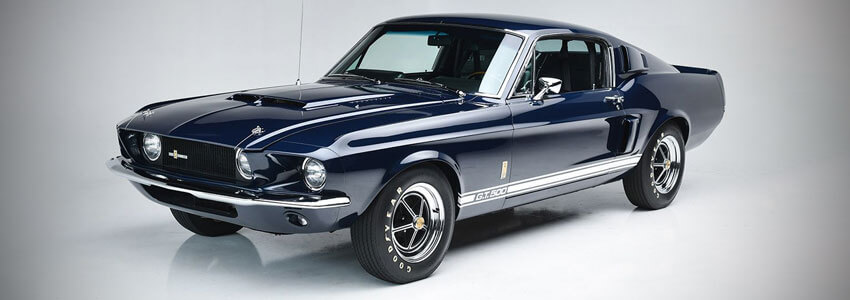
1967 Shelby GT500
At the beginning of 1967, a lot was happening throughout the United States including the Mustang's top
competitor debuted in the Chevrolet Camaro, the start of the height of the muscle car era, and most
importantly the debut of the most prolific type of venom to come out of Shelby yet during this era; in
the Shelby GT500. This sinister serpent was the answer to a growing trend of all-out muscle from the big
three automakers in Detroit. Through many years of innovation, Carroll saw if he could bring the biggest
punch of power, sophistication, and handling to the American muscle world. Starting with the basis of
'67 Mustang GT Fastback, Shelby got to work by stripping everything that the GT500 didn't need to
increase the most amount of performance possible.
Unlike, the Mustang GT, or GT350, the GT500 were engineered to be the king of all Cobras in the Shelby
Mustang lineup. Taking design cues from the GT350, the GT500 would have a revised functional ram air
style hood to help feed all the cold air necessary to power the monster 427 cubic inch V8 found in the
Ford GT MKII and Ford NASCAR race cars at the time. The GT500 would need an abundance of chassis
rigidity throughout the frame and strut tower bracing to handle all of this power. Furthermore, with 355
horsepower and 420 lb/ft of torque, the 67 GT500 was the most prolific and influential Mustang to ever
come out of Shelby and Ford.
What made the 1967 Shelby GT500 so significant is that it was the first car that Carroll Shelby was
incredibly proud of, he said. Between himself, Lee Iacocca, and Mustang engineers, they could turn the
pony into a slithering serpent of a beast. The notion that Shelby said you couldn't turn a mule into
racehorse was finally over after a legend's birth. It started a legacy of ultimate Shelby and Ford
performance that is as significant as American freedom and apple pie.
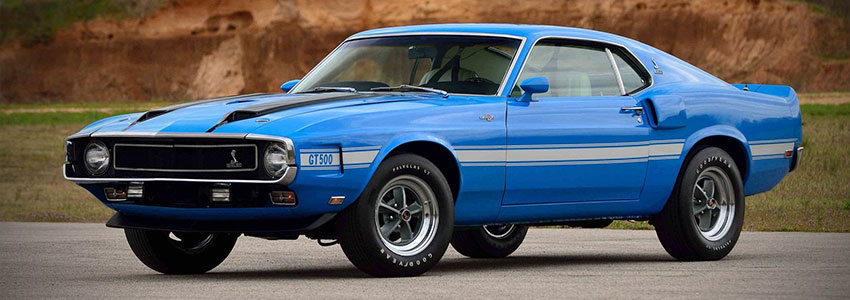
1969-1970 Shelby GT500
The Shelby GT500 helped kicked off an era of all-out American muscle car performance that many
enthusiasts still revere even in today's modern world of muscle. Heading into the new decade, Ford was
at the height of its Trans-Am racing prowess and the fabulous winnings in the NASCAR circuit. With the
1970 Mustang fastback launch came an all-new updated design with a longer wheelbase that spoke nothing
but muscle and speed. Both the 1969 and 1970 share the same chassis and architecture, but specific
design cues only come from the GT500. During the 1970 model year, the Shelby GT500 received a much
longer hood than before using ram-air technology to feed the monstrous 7.0L 428 Cobra Jet, which
produced a whopping 335 horsepower and earth rotating 440 lb/ft of torque which at the time was
jaw-dropping. All of this power helped the 69 and 70 GT500 reach zero to sixty in just 6.0 seconds, in
that time was unbelievable.
As all Shelby's go it is immediate recognizable styling, for both years, the Shelby
snake received a full car length side stripe with the GT500 emblem on the front fender, engine cobra
badge on the top-rear of the fender. The front fascia commands presence while maintaining functionality
to give the GT500 all the air and aero that it ends to stay true to its performance nature. Moving
around to the rear end of the 1969 and 1970 Shelby GT500, it retains some styling cues from the 1967 and
1968 GT500 in the rectangle taillamps but accents the broader rear track width. Lastly, the most
significant piece to this generation of Shelby GT500 is the center-mounted dual exhaust that says, “I
mean business, and I am not messing around.” Altogether the 1969 & 1970 Shelby GT500 was sent off to the
first generation Mustang as it would no longer be produced after that.
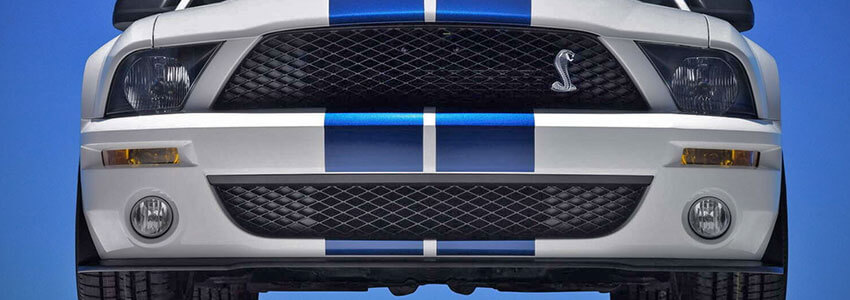
2007 Shelby GT500
At the beginning of the 1970s, it was the start and end of an era for Ford Motor Company and Shelby
American. During the 1960s, the two companies and icons built an empire of performance, racing, and
speed, which is still revered as one of the most incredible decades of dominance throughout the
automotive industry and history. After the 1970 Shelby GT500, Ford and Shelby would go their separate
ways for a long time due to the gas shortage and increase demand for more fuel-efficient vehicles.
Throughout the next forty years, it would be Ford's sole mission to make the Mustang as
performance-oriented as
possible to keep the brand and icon alive without the legend himself.
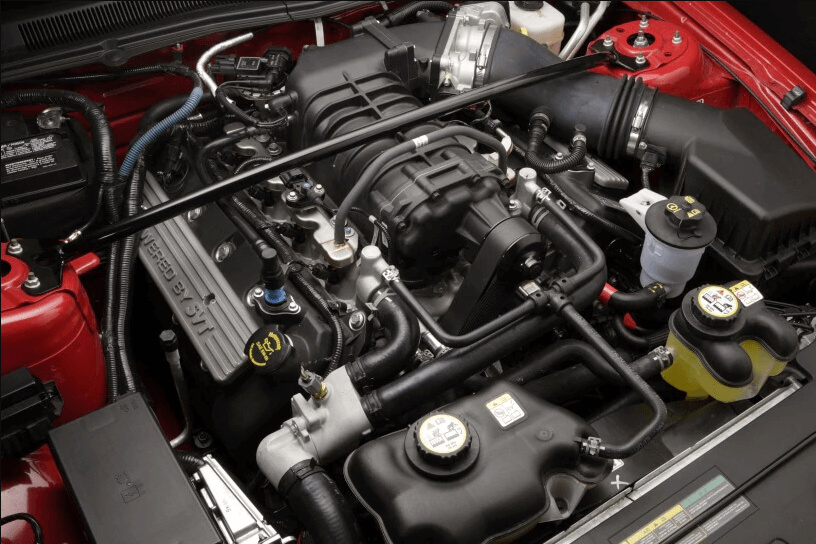
During this time apart from Ford, Shelby would take his talents and ingenuity to other manufacturers,
including Dodge, where Lee Iacocca left to help a struggling brand be revitalized and restored to its
former 60s glory days. Carroll would help create some really fun but yet efficient Dodge Chargers with a
Shelby flavor on them with performance parts along with the styling. During this time, these cars he was
especially building were pretty formidable for little four-cylinder turbo cars during the late 1970s and
early 1980s. Other than the original Shelby Cobra, Carroll was responsible for helping Dodge create a
modern interpretation of the venomous 427 Cobra. In 1989, Dodge and Shelby would team up for a final
time to produce the Dodge Viper R/T 10, which was a roadster that harkened the essence of the original
sixties-era Cobra. With a naturally aspirated big block V10 engine producing 400 horsepower, it was his
ingenuity that helped Dodge immersed themselves as a dominant brand in America.
Fast-forwarding to the late 2000s, the S197 was in full fledge of production, and enthusiasts everywhere
were revering its throwback design that harkened to the original 1960s era. Ford had something in the
works to finally bring back the living legend for the fortieth anniversary of the 1967 Shelby GT500.
During the New York auto show in 2006, both Ford and Shelby debuted the most potent production GT500
ever to be built. With 500
horsepower and 480 lb/ft of torque and a low four seconds, zero to sixty
times, this new breed of venom was unlike anything ever seen in the public eye. Every Shelby enthusiast
went off the walls with excitement and couldn't wait to get their hands on the new addition. For the
next seven years, Ford and Shelby would start another reign of performance that would challenge the
likes of the 1960s.
2007 Shelby GT500 Engine Specs
| Measurement |
Technical Specification |
| Configuration |
Iron block and Aluminum heads |
| Intake Manifold |
Intercooled 1.9L Eaton M122 Supercharger |
| Exhaust Manifold |
Cast Iron |
| Valvetrain |
DOHC (Dual Overhead Cam), 32V |
| Pistons |
Forged Aluminum |
| Connecting Rods |
Forged Cracked I-Beam |
| Ignition |
Distributor-less coil on plug design |
| Bore X Stroke |
3.55 in. x 4.17 in. |
| Displacement |
330 Cubic Inches/5.4L |
| Compression Ratio |
11.0:1 |
| Engine Control Sytem |
PCM |
| Horsepower |
500 @ 6,000 RPM |
| Torque |
480 LB/FT of Torque @ 4,500 RPM |
| Recommended Fuel |
93 Octane |
| Fuel Delivery |
Electronic Returnless Sequential Fuel Injection |
| Oil Capacity |
6.4 5W-50 w/Oil Filter 3K Mile Intervals |
| Redline |
6,250 RPM |

2013-2014 Shelby GT500
In the later parts of 2012, Ford and Shelby were in the works to create the most potent variation
of
venom ever to hit America's streets. With the S197 in its full strength of options, performance,
and
styling Ford, SVT, and Shelby had to take advantage of creating the greatest GT500 ever to be
built from
the factory. With so much technology being integrated into the Mustang, something had to be done
to
create the most magnificent handling, most powerful, and sophisticated venom variation. During
the New
York auto show in 2012, Ford and Shelby debuted the 2013 Shelby GT500. Introducing it with the
"Trinity"
5.8L Supercharged V8 would produce the most potent Shelby ever to built-in 662 horsepower and
635 lb/ft
that culminated in the last seven years of performance together showcasing the possibilities
again when
the two work together.
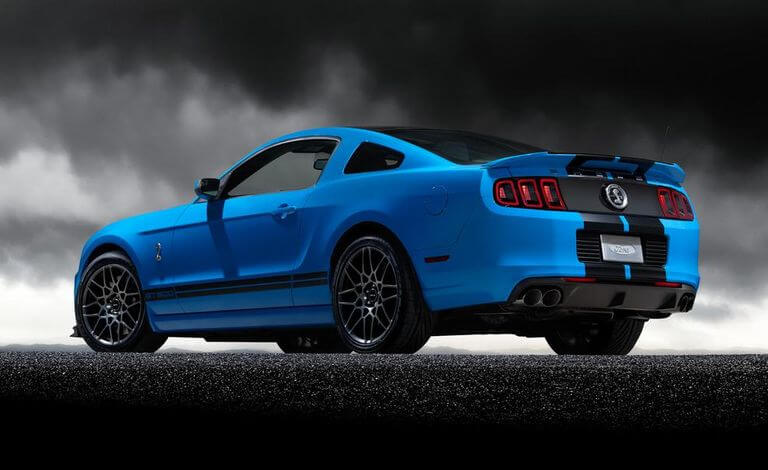
During this time, it was the most potent mass-produced V8 ever to be build among any
manufacturers
throughout the world. Among the big three auto manufactures, the "Trinity" modular engine would
take the
GT500 to reach 200 miles an hour, the first time that a factory-built Shelby would ever be able
to break
the 200 MPH. Along with reaching a 3.8 0-60 mph, which as the time was the fastest ever for
Shelby to
reach that speed. Along with all the brute force power, you would expect a GT500; this variant
would
feature a first-ever active damper shocks, drive modes, and launch control. These areas of
components
and technology helped launch the GT500 into a new realm of performance.
Unfortunately, this would be the last Shelby GT500 the two would ever put together due to Carroll
Shelby's death in 2012 at 89 years of age. He left an eternal legacy of style, charisma,
performance,
and racing for many enthusiasts to come for generations. Throughout the Mustang, Cobra, and Ford
world,
everyone was disheartened by losing an American racing and automotive icon, but his legacy will
continue
for many years to come.
2013-2014 Shelby GT500 Engine Specs
| Measurement |
Technical Specification |
| Configuration |
Cast aluminum block and head with
plasma transfer wire arc cylinder liners |
| Intake Manifold |
Air-To-Water Intercooled 2.3L Eaton TVS 2300 Supercharger |
| Exhaust Manifold |
Tubular stainless steel headers |
| Valvetrain |
DOHC, 32 valve (4v per cylinder) |
| Pistons |
Forged aluminum |
| Connecting Rods |
Forged Forged ALuminum |
| Ignition |
Distributor-less with coil-on-plug |
| Bore X Stroke |
3.68 in. x 4.17 in. |
| Displacement |
351 Cubic inches/5.8L |
| Compression Ratio |
9.0:1 |
| Engine Control Sytem |
PCM |
| Horsepower |
662 @ 6,200 RPM |
| Torque |
631 ft.-lbs. @ 4,000 rpm |
| Recommended Fuel |
93 Octane |
| Fuel Delivery |
Electronic Returnless Sequential Fuel Injection |
| Oil Capacity |
8 quarts 5W-30 full synthetic with filter
(5,000-mile service interval, 3,000 for
heavy use) |
| Redline |
7,000 RPM |
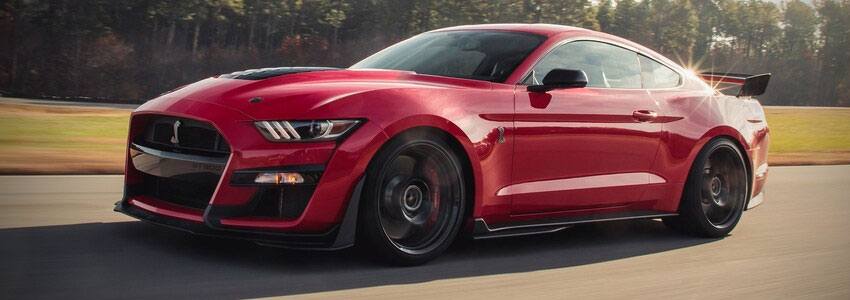
2020 Shelby GT500
After the death of Carroll Shelby, it was the rite of Ford and Ford Performance to take on the
legacy of
the legend. After the end of the S197, Ford worked tirelessly to create the next generation S550
Mustang
to become the most prolific pony to come out of the stable. Like every generation of Mustang,
there must
always be a new breed and cocktail of venom to be produced to shock the world of American
automotive
performance. As each year passed on by enthusiasts everywhere would wonder when the all-new
Shelby GT500
would debut? Most notably, after the Shelby GT350 made an infamous comeback to dealer showrooms
everywhere in late 2015. For many enthusiasts, it was a struggle due to the heat that Ford's
competitors
Mopar and Chevrolet brought to the table in the Camaro ZL1 with 650 horsepower and Challenger
SRT
Hellcat in a monstrous 707 strength.
After many years of speculation, the news finally broke out in 2019 when Jim Farley VP of Ford
Motor
Company debuted what to be known as the most lunatic viral of venom to be ever put forth in 2019
Detroit
International Auto Show. As speculated, it would consist of a variant of the 5.2L "Voodoo" V8
found in
the Shelby GT350 &
GT350R. The 2020 Shelby GT500 would be embedded with the " Predator" 5.2L cross-plane crank
Eaton Supercharged
V8 producing an enormous amount of venom in 760 horsepower and 650 lb/ft of torque,
redlining at 7500 RPM. Most notability it would receive a Ford in a Tremec TR9070 7-Speed
Dual-Clutch Gearbox just as the Ford GT gets a Dual Clutch trans-axle system for the 3.5L
Twin-Turbo EcoBoost V6 making a staggering 647 horsepower.
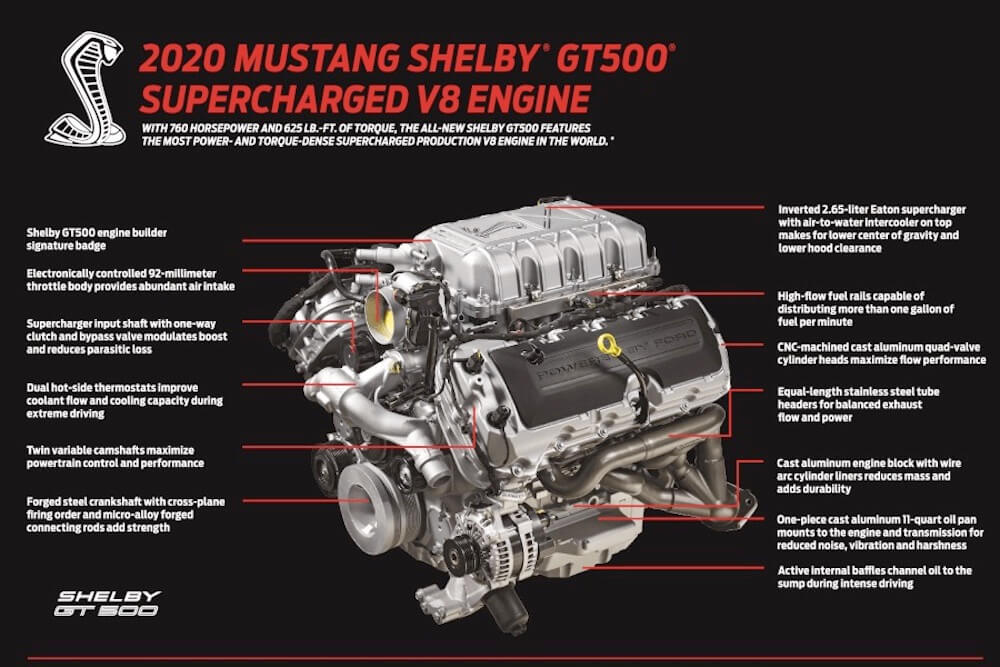
Unlike other GT500 models of the past, this new breed of venom features an entirely new
versatility of
tools in its arsenal. Instead of just going stupid fast in a straight line, it would be
able to corner
just as hard and quick as a GT350R but still have the ferocious bite that enthusiasts
are accustomed to
in the GT500. The 2020
GT500 features unique aerodynamics, a carbon fiber track package that includes a
specific GT4 carbon fiber rear spoiler, unique twenty-inch carbon fiber wheels, Michelin Pilot Sports
Cup 2 tires, larger front splitter, and winglets. All combined help the GT500 reach a staggering 180 MPH
top speed while hitting 3.6 seconds, which means it is the fastest ever out of the factory in terms of
acceleration.
Over fifty years, Ford and Shelby have created an automotive icon that rival any European
or Japanese performance vehicle. Everyone knows when you see the menacing Cobra badge on the fender you
or its menacing eyes, you know to get the hell out its way or get bitten with its insane amount of
power. We genuinely look forward to the continuing legacy of the Shelby GT500, and we wonder what Ford
will do to the next generation to keep the legend alive and well.
Shelby GT500 Predator Engine Specs
| Measurement |
Technical Specification |
| Configuration |
Cast aluminum block and head with
plasma transfer wire arc cylinder liners |
| Intake Manifold |
Cast aluminum with integrated
supercharger and CAE designed NVH
features |
| Exhaust Manifold |
Tubular stainless steel headers |
| Valvetrain |
DOHC, four valves per cylinder, twin
independent variable camshaft timing |
| Valve Diameter/Lift |
Intake, 38.3 mm/14 mm;
exhaust, 32.5 mm/14 mm |
| Pistons |
Forged aluminum |
| Connecting Rods |
Forged micro-alloyed steel |
| Ignition |
Distributor-less with coil-on-plug |
| Bore X Stroke |
3.70 in. x 3.66 in. (94.0 mm x 93.0 mm) |
| Displacement |
315 Cubic inches/5.2L |
| Compression Ratio |
9.5:1 |
| Engine Control Sytem |
PCM |
| Horsepower |
760 @ 7,300 RPM |
| Torque |
625 ft.-lbs. @ 5,000 rpm |
| Recommended Fuel |
93 Octane |
| Fuel Delivery |
Port fuel injection with twin high-flow pumps |
| Oil Capacity |
11.5 quarts 5W-50 full synthetic with filter
(5,000-mile service interval, 3,000 for
heavy use) |
| Redline |
7,500 RPM |

Related
Articles
Image Credit: Ford Motor Company, Ford
Performance, Mecum Auction,
Motor Trend














